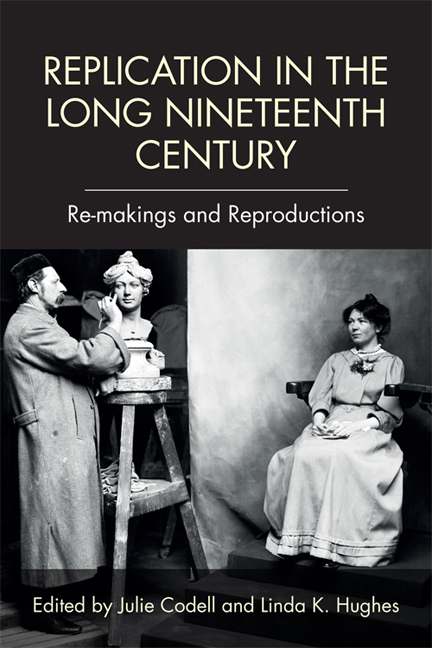Book contents
- Frontmatter
- Contents
- List of Illustrations
- Acknowledgments
- 1 Introduction: Replication in the Long Nineteenth Century – Re-makings and Reproductions
- I Replication and Networks
- 2 Replication of Things: The Case for Composite Biographical Approaches
- 3 Transatlantic Autograph Replicas and the Uplifting of American Culture
- 4 “Petty Larceny” and “Manufactured Science”: Nineteenth-Century Parasitology and the Politics of Replication
- 5 Portraying and Performing the Copy, c. 1900
- II Replication and Technology
- III Replication and Authenticity
- IV Replication and Time
- Notes on Contributors
- Index
5 - Portraying and Performing the Copy, c. 1900
from I - Replication and Networks
Published online by Cambridge University Press: 11 August 2018
- Frontmatter
- Contents
- List of Illustrations
- Acknowledgments
- 1 Introduction: Replication in the Long Nineteenth Century – Re-makings and Reproductions
- I Replication and Networks
- 2 Replication of Things: The Case for Composite Biographical Approaches
- 3 Transatlantic Autograph Replicas and the Uplifting of American Culture
- 4 “Petty Larceny” and “Manufactured Science”: Nineteenth-Century Parasitology and the Politics of Replication
- 5 Portraying and Performing the Copy, c. 1900
- II Replication and Technology
- III Replication and Authenticity
- IV Replication and Time
- Notes on Contributors
- Index
Summary
Lecturing to students at the Metropolitan Museum of Art in 1916, William Merritt Chase announced,
I have been a thief. I have stolen all my life. I have never been so foolish and fool-hardy as to refrain from stealing for fear I should be considered as not “original.” Originality is found in the greatest composite that you can bring together. (“William Merritt Chase as Teacher” 252)
In the years leading up to this statement, Chase's practice, like that of many of his contemporaries such as John Singer Sargent, Cecilia Beaux, and Thomas Eakins, included – in a variety of orders – painting copies of Old Master paintings, studying photographs of those paintings, staging models in live performances based on the paintings, and photographing the arranged models. Through their artistic training and processes, these artists and their peers engaged in acts of copying, translation, and replication across media in the wake of advances in imaging technologies (Figure 5.1). Beyond the practice of copying European masters as central to their formal academic training, they also photographed models and worked from both life and photographs to translate the images onto canvas. The merging of various identities in a contemporary model's face through the performance of copies of European paintings particularly seemed to intrigue Chase. His engagement with the highly popular activity of staging tableaux vivants – performances that replicated paintings and sculpture – combined with his arrangement of models, including family members, for photographs to be studied or published after the performances, allowed Chase to collaborate with his portrait subjects and audience in the making of living replicas of European portraits (Figure 5.2). The photographs indicate that he was thinking about experiments in forms of portraiture, including photographic Pictorialist practices, and they also have a particular significance when considered in light of late nineteenth- and early twentieth-century dialogues surrounding the uses and meanings of photographic copies of paintings in museums in the wake of rapid advances in imaging technology.
- Type
- Chapter
- Information
- Replication in the Long Nineteenth CenturyRe-makings and Reproductions, pp. 84 - 100Publisher: Edinburgh University PressPrint publication year: 2017

